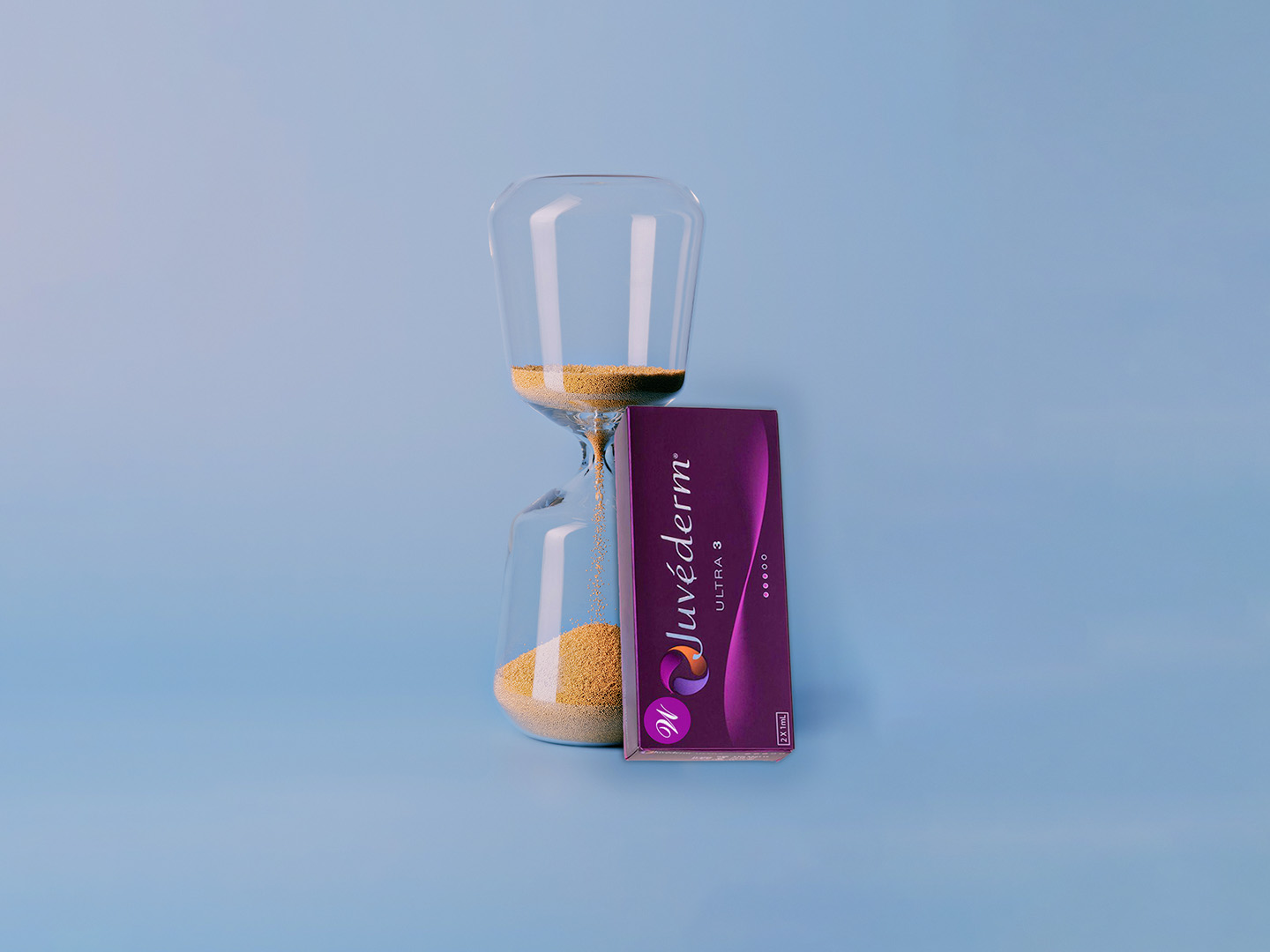
For medical aestheticians, understanding how long dermal fillers last isn’t just a matter of product knowledge; it’s essential for treatment planning, setting patient expectations, and scheduling timely follow-ups. Juvederm fillers are among the most trusted options for soft tissue augmentation, but their longevity can vary widely depending on where they’re placed, the specific product used, and who the patient is. A patient may walk in expecting their lip filler to last as long as their cheek augmentation, not realizing that different areas of the face, and the way those areas move, directly influence how quickly fillers break down. That’s where your clinical judgment comes in.
In this guide, we’ll break down the factors that affect how long does Juvederm last in different facial areas, why some products perform better in specific zones, and how to create maintenance plans that keep results looking fresh without overcorrection. Whether you’re treating the lips, under-eyes, jawline, or everything in between, understanding filler longevity helps you work smarter, and helps your patients feel more satisfied long-term.
What Is Juvederm and How Long Does It Last?
Juvederm is a family of hyaluronic acid-based fillers manufactured by Allergan. HA is a naturally occurring substance that attracts water, making it ideal for volumizing and hydrating the skin.
In general, Juvederm dermal fillers last anywhere from 6 to 24 months depending on the type of product, the treatment area, and individual factors.
There are two main technologies behind Juvederm fillers:
- Hylacross technology (e.g., Juvederm Ultra, Ultra Plus) creates a smooth gel that’s ideal for dynamic areas but tends to break down more quickly.
- Vycross technology (e.g., Voluma, Vollure, Volbella) blends high and low molecular weight HA, making the filler more resistant to degradation and longer-lasting.
Matching the filler type to the facial area and movement level is key to maximizing longevity.
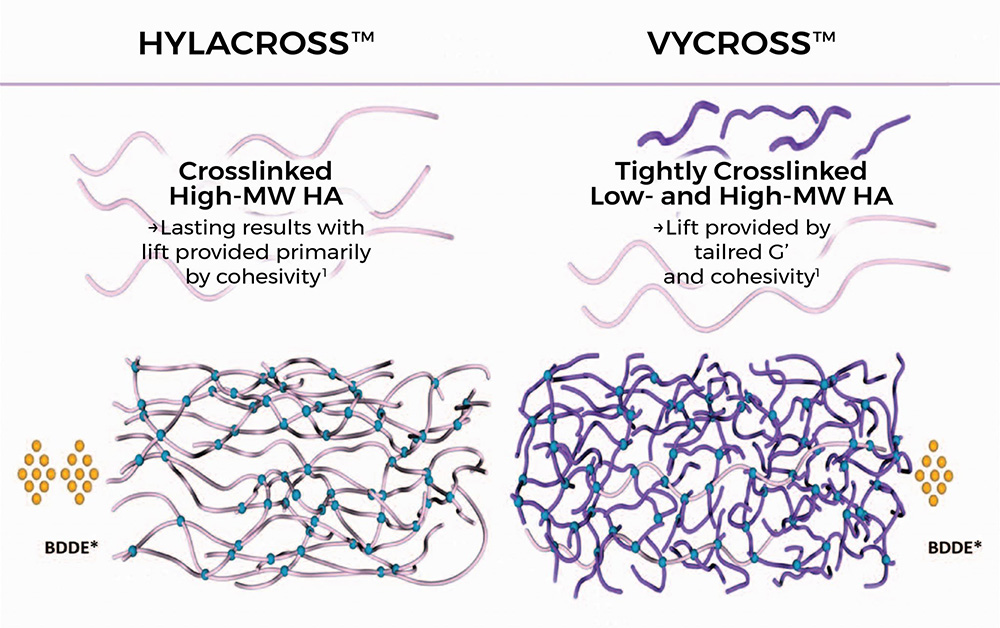
How Facial Area Affects Juvederm Duration
Facial movement plays a major role in how quickly fillers degrade. Areas that move frequently during expression, speaking, or eating naturally break down hyaluronic acid more rapidly than more static zones.
Shorter-Lasting Areas (High Movement)
- Lips and Perioral Region: These areas are constantly in motion, so fillers like Juvederm Ultra XC or Volbella XC typically last 6 to 9 months. Juvederm lip filler longevity also depends on product selection, with thicker gels like Ultra lasting slightly longer than softer options like Volbella.
- Nasolabial Folds: Moderate movement can cause fillers here to last around 9 to 12 months, depending on the product.
Longer-Lasting Areas (Low Movement)
- Cheeks: The midface has less repetitive motion and more structural support. Juvederm Voluma XC used in this area can last up to 24 months.
- Chin and Jawline: These zones tend to hold filler well, especially when using firmer products like Voluma. Results can last 18 to 24 months.
- Why does movement matter? Hyaluronic acid fillers degrade through enzymatic and mechanical processes. Repetitive motion increases the physical stress on the gel, speeding up its breakdown.
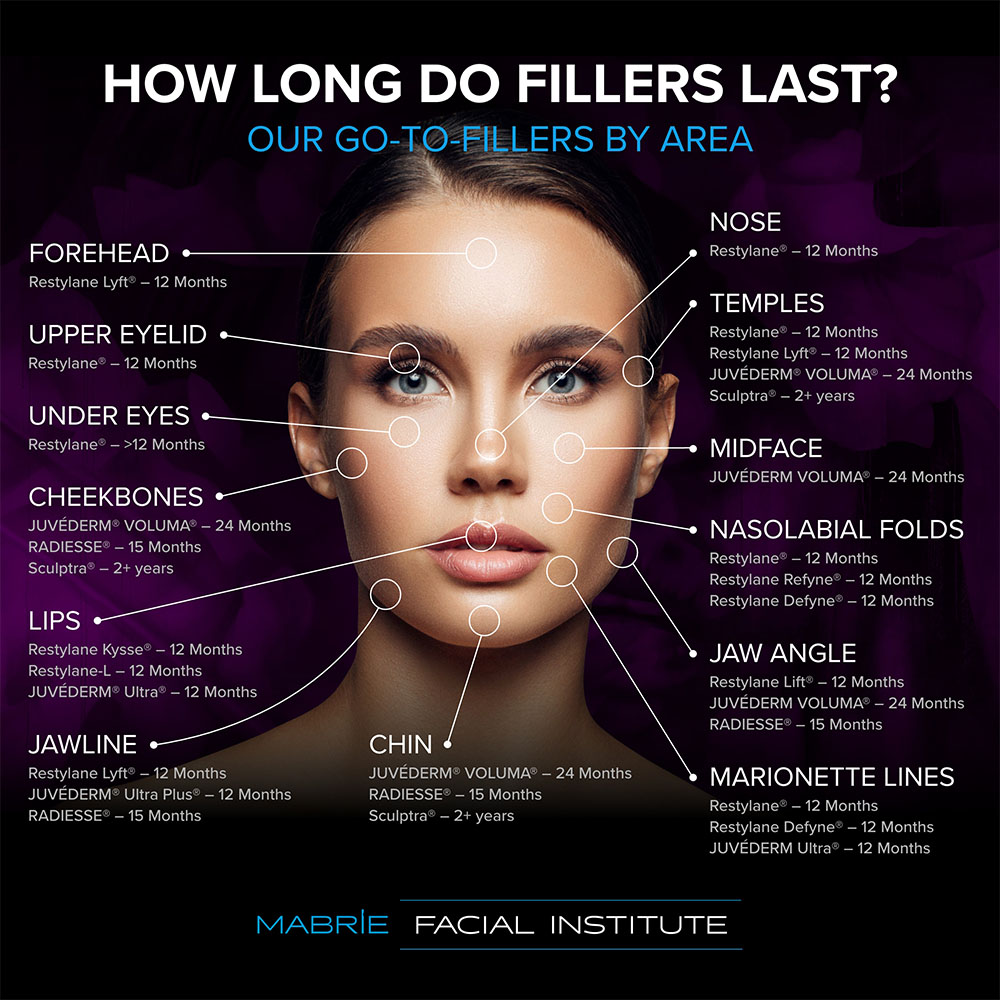
Patient-Specific Factors That Influence Longevity
No two patients metabolize fillers in exactly the same way. Several personal factors affect how long Juvederm lasts:
- Age and Skin Quality: Thinner, sun-damaged, or aging skin may not hold filler as well. Younger patients with better collagen density may see longer-lasting effects.
- Metabolic Rate: Patients with a high metabolism or those who exercise vigorously often break down HA fillers faster.
- Lifestyle Habits: Smoking, frequent sun exposure, poor hydration, and lack of skincare can all reduce filler longevity.
- Biological Response to HA: Some patients naturally metabolize HA more quickly. Others may retain product longer than expected.
It’s important to track how a patient responds over time and tailor touch-up timelines based on their unique breakdown pattern.
Product Selection by Facial Area
Choosing the right Juvederm filler for each facial area can greatly affect longevity and outcomes. The texture (rheology), firmness, and crosslinking density of the gel must be matched to the anatomy and desired result.
- Lips & Tear Troughs:
o Recommended: Juvederm Volbella XC
o Why: Soft, smooth, and integrates well into delicate tissue
o Duration: ~9–12 months
- Cheeks & Chin:
o Recommended: Juvederm Voluma XC
o Why: High lifting capacity, structural support
o Duration: ~18–24 months
- Nasolabial Folds & Marionette Lines:
o Recommended: Juvederm Ultra Plus XC or Vollure XC
o Why: Good volume retention in dynamic areas
o Duration: ~12–18 months
Matching filler viscosity and elasticity to the treatment goal is key. Firmer gels provide structure and last longer in static areas. Softer gels blend better in high-movement or superficial regions.
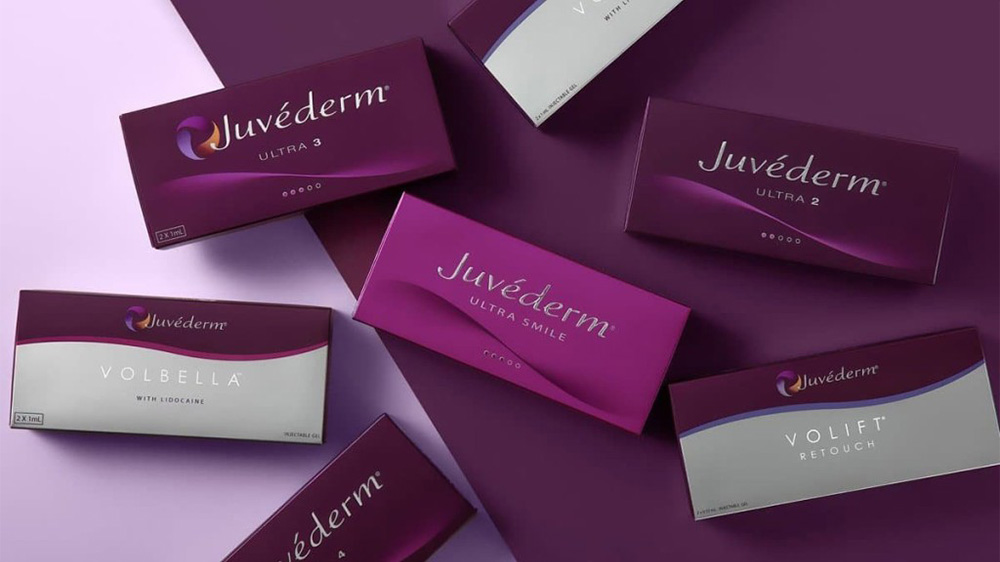
Technique-Related Factors
The injector’s technique directly influences how long Juvederm lasts.
- Injection Depth: Deeper placement in the appropriate plane (e.g., supraperiosteal for Voluma) often prolongs filler life.
- Quantity: Overfilling can distort results, but too little may lead to faster product degradation.
- Layering Strategy: Staging treatments over time with multiple sessions can yield longer-lasting results.
- Precision & Safety: Placing filler in the correct anatomical layer minimizes migration and uneven breakdown.
Skilled injectors with deep anatomical knowledge and conservative techniques tend to achieve results that look better and last longer. Ongoing aesthetic medicine courses are recommended to refine these techniques, especially for areas prone to complications.
Maintenance and Follow-Up Strategy
Maintaining Juvederm results requires more than just a good injection technique—it also means helping patients understand when to come back and how to support their results.
In general, touch-ups are recommended every 6 to 12 months for most facial areas, with longer intervals (up to 24 months) for products like Voluma used in the cheeks or chin. Rather than waiting for a full product breakdown, proactive top-ups help preserve consistent results and prevent noticeable volume loss.
Patient education is key. Explain that filler longevity depends on where it's injected, their metabolism, and lifestyle habits. Encourage them to watch for signs like softening volume or returning lines, and let them know that maintenance is normal—not a sign that something went wrong.
Follow-up schedules should be personalized based on the area treated, product used, and how the individual metabolizes hyaluronic acid. Supporting their results through sun protection, hydration, and healthy habits also plays a role in longevity.
Ultimately, building a realistic and personalized plan keeps results looking natural and keeps patients coming back with confidence.
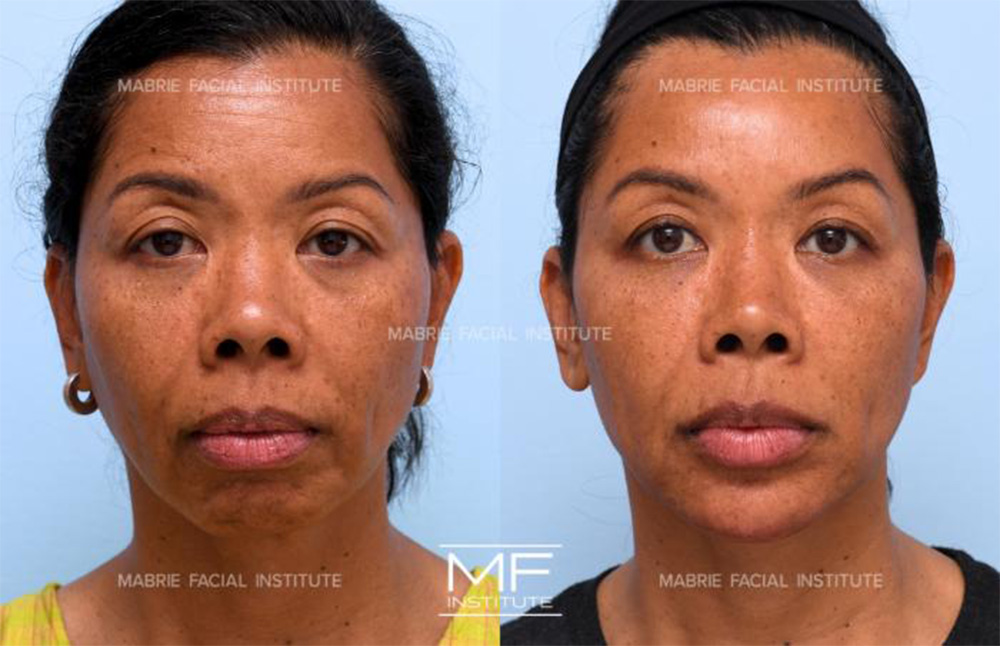
Frequently Asked Questions
Does Juvederm last longer than Botox?
Yes. Juvederm can last 6 to 24 months, depending on the area and product. Botox typically lasts 3 to 4 months, as it targets muscle movement rather than adding volume.
Does Juvederm help under-eye bags?
It can. Juvederm Volbella is commonly used for tear trough correction. It fills hollows and can soften the appearance of under-eye bags when placed properly.
Is it worth getting Juvederm?
For many patients, yes. Juvederm offers noticeable improvements in facial structure and smoothness with minimal downtime. Patient satisfaction is high when expectations are realistic.
Is 2 syringes of Juvederm a lot?
Not necessarily. For facial balancing, 1–2 syringes is a common starting point. Cheek augmentation or combined lip and chin work may require 2 or more.
Can fillers make you look 10 years younger?
Fillers can significantly refresh facial appearance, especially when combined with other treatments. While they won’t turn back the clock completely, they often restore volume loss that contributes to an aged look, as can be seen on Juvederm before and after photos.
Conclusion
Juvederm offers long-lasting and customizable results, but how long it lasts depends on much more than the product alone. The treated area, the patient’s metabolism, the type of filler used, and the injection technique all come into play. High-movement zones like the lips break down filler faster, while structural areas like the cheeks and chin hold product longer.
As a medical aesthetician, your role is to choose the right Juvederm filler, educate patients on realistic outcomes, and create long-term treatment plans built around both beauty and biology. When paired with professional training, like Juvederm training courses online you’ll be equipped to deliver results that last and meet your patient’s goals every time.
Sources
- Smith SR, Jones D, Thomas JA, Murphy DK, Beddingfield FC 3rd. Duration of wrinkle correction following repeat treatment with Juvéderm hyaluronic acid fillers. Arch Dermatol Res. 2010;302(10):757-762. doi:10.1007/s00403-010-1086-8 https://pubmed.ncbi.nlm.nih.gov/20936295/
- Bertroche JT, Radder M, Kallogjeri D, Paniello RC, Bradley JP. Patient-defined duration of benefit from juvederm (hyaluronic acid) used in injection laryngoplasty. Laryngoscope. 2019;129(12):2744-2747. doi:10.1002/lary.27842 https://pubmed.ncbi.nlm.nih.gov/30698821/
- Monheit GD, Prather CL. Juvéderm: a hyaluronic acid dermal filler. J Drugs Dermatol. 2007;6(11):1091-1095.https://pubmed.ncbi.nlm.nih.gov/18038495/
Disclaimer:
This article is intended for licensed medical professionals. All protocols, dosages, and treatment insights referenced herein are based on published literature. The content is not intended to encourage application, diagnosis, or self-treatment of unlicensed individuals, and should not be used as a substitute for the clinical judgment of a qualified healthcare provider.

